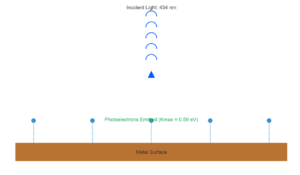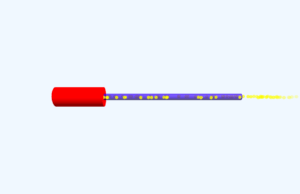De Broglie Wavelength Simulation
This simulation demonstrates the de Broglie wavelength (λ = h/p) for both quantum particles (electrons) and macroscopic objects (a ball). The wavelength is inversely proportional to the momentum (p = mv), showing how quantum effects are significant for small particles but negligible for everyday objects.
Example
Question:
What is the de Broglie wavelength associated with (a) an electron moving with a speed of \( 5.4 \times 10^6~\text{m/s} \), and (b) a ball of mass 150 g travelling at \( 30.0~\text{m/s} \)?
Solution:
(a) For the electron:
Mass \( m = 9.11 \times 10^{-31}~\text{kg} \), speed \( v = 5.4 \times 10^6~\text{m/s} \)
Momentum \( p = m v = 9.11 \times 10^{-31} \times 5.4 \times 10^6 = 4.92 \times 10^{-24}~\text{kg m/s} \)
de Broglie wavelength:
\[
\lambda = \frac{h}{p} = \frac{6.63 \times 10^{-34}~\text{Js}}{4.92 \times 10^{-24}~\text{kg m/s}} = 0.135~\text{nm}
\]
(b) For the ball:
Mass \( m' = 0.150~\text{kg} \), speed \( v' = 30.0~\text{m/s} \)
Momentum \( p' = m' v' = 0.150 \times 30.0 = 4.50~\text{kg m/s} \)
de Broglie wavelength:
\[
\lambda' = \frac{h}{p'} = \frac{6.63 \times 10^{-34}~\text{Js}}{4.50~\text{kg m/s}} = 1.47 \times 10^{-34}~\text{m}
\]
The electron's de Broglie wavelength is X-ray scale; for the ball, it is ~\( 10^{-19} \) times proton size, beyond experimental measurement.


